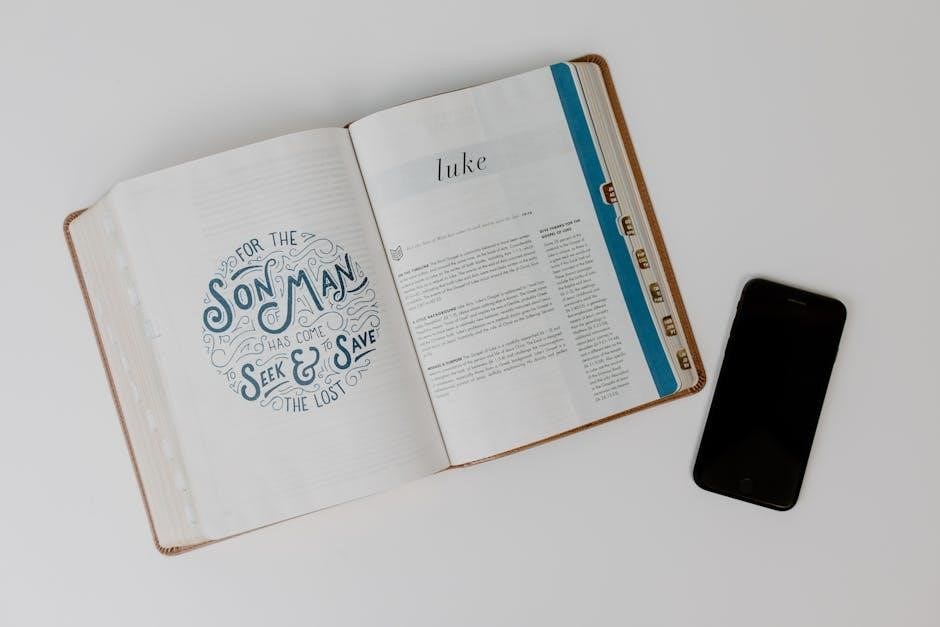canon 7d mark ii instruction manual
Canon EOS 7D Mark II Instruction Manual: Comprehensive Guide
Welcome to the Canon EOS 7D Mark II Instruction Manual, your ultimate guide to mastering this powerful APS-C DSLR camera. Designed for enthusiasts and professionals, this manual covers everything from initial setup to advanced shooting techniques, ensuring you unlock the full potential of your camera. Explore features like 20.2MP resolution, weather-sealing, and advanced autofocus systems. Learn how to customize settings, use manual focus, and optimize image quality. Whether you’re capturing sports, wildlife, or portraits, this guide will help you achieve stunning results. Dive in and discover how to make the most of your Canon EOS 7D Mark II!

Welcome to the Canon EOS 7D Mark II, a high-performance APS-C DSLR designed for enthusiasts and professionals. Featuring a 20.2MP CMOS sensor, this camera delivers sharp, detailed images with excellent low-light performance. Built with durability in mind, it boasts weather-sealing for harsh conditions and an advanced 65-point autofocus system for precise subject tracking. Ideal for sports, wildlife, and action photography, the EOS 7D Mark II combines speed, versatility, and superior image quality, making it a reliable tool for capturing life’s fleeting moments with precision and creativity.
Key Features of the Canon EOS 7D Mark II
The Canon EOS 7D Mark II stands out with its 20.2MP APS-C CMOS sensor, delivering crisp images and excellent low-light performance. It features a robust 65-point all-cross-type AF system for rapid and precise subject tracking. The camera offers continuous shooting at 10 fps, perfect for capturing fast-moving subjects. Weather-sealing ensures durability in challenging environments, while dual memory card slots provide ample storage. Additionally, it supports Full HD video recording at 60p and offers customizable controls, making it a versatile choice for both photography and videography enthusiasts.
First-Time Setup and Initialization
Before using your Canon EOS 7D Mark II, ensure proper initialization. Begin by charging the battery and installing it along with a memory card. Attach the lens and adjust the viewfinder to your eyesight. Turn on the camera and navigate through the initial setup menu to set language, date, time, and image quality settings. Refer to the manual for detailed guidance on firmware updates and customizing initial preferences. Proper setup ensures optimal performance and personalization for your photography needs.
Unboxing and Initial Inspection
When unboxing your Canon EOS 7D Mark II, carefully inspect the contents to ensure all items are included, such as the camera body, battery, charger, and manual. Examine the camera for any visible damage or defects. Gently remove any protective coverings and attach the strap for secure handling. Clean the lens and sensor with a soft cloth to prevent dust or smudges; Familiarize yourself with the camera’s exterior, locating key controls like the mode dial, shutter button, and autofocus joystick. This step ensures your camera is ready for its first use and helps you understand its layout.
Charging the Battery and Installing the Memory Card
Before using your Canon EOS 7D Mark II, charge the battery using the provided charger until the indicator turns green. Avoid using third-party chargers to prevent damage. Insert the battery into the camera, ensuring it clicks securely into place. Next, install a compatible memory card (CF or SD/SDHC/SDXC) by sliding it into the card slot until it locks. Always handle cards by the edges to avoid static damage. Format the card in the camera menu to ensure optimal performance. This step prepares your camera for capturing high-quality images and videos seamlessly.
Setting Up the Camera for the First Time
Insert the charged battery and memory card into the camera. Turn it on and follow the setup wizard to select your language, date, and time. Choose your time zone and set the correct date format. The camera will guide you through sensor cleaning and firmware updates if available. Once complete, review the settings to ensure accuracy. This initial setup ensures your camera is ready for use, with proper configurations for capturing images and videos effectively. Refer to the manual for detailed instructions on customizing additional settings.
Getting Started with Basic Photography
Begin by understanding the exposure basics: ISO, aperture, and shutter speed. Use the mode dial to select Auto or Manual modes, depending on your preference. Familiarize yourself with autofocus by pressing the shutter button halfway. Experiment with different metering modes to achieve accurate exposures. Review your images on the LCD screen and adjust settings as needed. Practice composing shots using the rule of thirds and leading lines. Start with simple subjects like landscapes or still life to build confidence. This foundation will help you progress to more complex photography techniques.
Understanding the Mode Dial and Shooting Modes
The mode dial on the Canon EOS 7D Mark II offers various shooting options to suit your needs. Auto mode simplifies photography for beginners, while P (Program) mode provides flexibility with automatic settings. Tv (Shutter Priority) and Av (Aperture Priority) modes allow control over shutter speed and aperture, respectively. Manual (M) mode offers full control for advanced users. Custom modes (C1-C3) enable you to save personalized settings for quick access. Experiment with these modes to enhance your creativity and adapt to different shooting scenarios, ensuring optimal results in any situation.
Navigating the Camera’s Menu System
The Canon EOS 7D Mark II features an intuitive menu system designed for easy navigation. Use the Quick Control dial and Multi-controller to scroll through options. The menu is divided into tabs for Shooting, AF, Playback, and Setup. Access key settings like ISO, white balance, and autofocus modes quickly. Customize options like My Menu to save frequently used settings. The menu also provides guidance for firmware updates and maintenance tasks, ensuring optimal camera performance. Explore the menu to unlock advanced features and tailor the camera to your photography style for exceptional results.
Using the Viewfinder and LCD Screen
The Canon EOS 7D Mark II features a 100% optical viewfinder for precise framing and a 3-inch LCD screen for menu navigation and image review. The Intelligent Viewfinder displays key shooting information, including AF points, metering, and ISO. Use the LCD to access menus, review shots, and adjust settings. The screen supports touch operations for intuitive control. Utilize the zoom feature to inspect image details and ensure sharp focus. Both tools work seamlessly to enhance your shooting experience, whether in live view or playback modes, providing clarity and convenience for capturing stunning images.
Customizing Your Shooting Experience
Customize your Canon EOS 7D Mark II to suit your photography style. Assign functions to buttons, create a personalized My Menu, and save custom shooting modes. The camera allows you to tailor settings like autofocus, metering, and white balance to your preferences. Use the Custom Shooting Mode (C1-C3) to save configurations for specific scenarios, ensuring quick access during shoots. This feature-rich system streamlines your workflow, making it easier to capture images exactly as you envision them. Personalize your camera for a more intuitive and efficient shooting experience, tailored to your creative needs.
Customizing Buttons and Controls
Personalize your Canon EOS 7D Mark II by customizing its buttons and controls to match your shooting style. Assign frequently used functions to buttons like the AF-on button or multi-controller for quick access. The camera allows you to reconfigure controls, enabling a more intuitive workflow. For example, you can set the multi-controller to adjust ISO or white balance directly. This feature enhances efficiency, letting you focus on composition and creativity during shoots. Tailor the controls to your preferences and streamline your photography process for optimal results. Customization ensures your camera works exactly how you need it to.
Creating a Custom My Menu
Streamline your workflow by creating a Custom My Menu on your Canon EOS 7D Mark II. This feature allows you to organize frequently used settings and functions in one convenient location. Access the menu system and select “My Menu” to add or arrange items like image quality, autofocus modes, and custom functions. You can also register personal settings for quick recall. This customization enhances efficiency, letting you focus on shooting rather than navigating through menus. Tailor your My Menu to suit your photography style and simplify your creative process. It’s a powerful tool for personalizing your camera experience.
Setting Up Custom Shooting Modes
Custom Shooting Modes on the Canon EOS 7D Mark II allow you to save personalized camera settings for quick access. Register your preferred combinations of aperture, shutter speed, ISO, and autofocus modes for specific scenarios, such as sports or portraits. Access the camera’s menu, navigate to “Custom Shooting Mode,” and select “Register Settings” to save your configurations. This feature streamlines your workflow, enabling rapid adjustments and ensuring consistency in your photography. It’s ideal for frequently changing environments, helping you capture moments seamlessly without missing a shot. Tailor your settings to perfection and shoot with confidence.
Focusing Techniques and Settings
Mastering focus on the Canon EOS 7D Mark II ensures sharp, professional-grade images. Use the 65-point autofocus system for precise subject tracking, especially in dynamic environments. Experiment with different AF modes—Single Shot AF for stationary subjects and AI Servo AF for moving ones. Fine-tune AF settings like tracking sensitivity and acceleration/deceleration to suit your subject’s motion. For manual focus, use the focus peaking feature in Live View for accurate adjustments. Customize focus priority settings to balance speed and accuracy, and assign custom buttons for quick AF adjustments. These techniques help you achieve sharp focus in any situation, enhancing your photography experience.
Using Autofocus (AF) Modes Effectively
Maximize the Canon EOS 7D Mark II’s autofocus capabilities by selecting the right AF mode for your subject. Single Shot AF is ideal for stationary subjects, locking focus instantly. AI Servo AF excels for moving subjects, continuously adjusting focus. Switch to AI Focus AF for automatic switching between modes. Use the 65-point AF system to track subjects precisely, and customize AF point selection for better composition. Adjust AF tracking sensitivity and acceleration/deceleration settings to match your subject’s movement. These features ensure sharp focus in dynamic shooting scenarios, enhancing your photography results.
Mastering Manual Focus for Precision
Manual focus on the Canon EOS 7D Mark II offers precise control, ideal for creative or challenging lighting conditions. Use the focus ring to adjust sharpness, and enable focus peaking for visual confirmation. For added accuracy, switch to Live View and zoom in on the subject using the LCD. The EOS 7D Mark II also supports manual focus with compatible lenses, ensuring sharp results. This mode is especially useful for macro photography, portraits, or when autofocus struggles. Master manual focus to achieve professional-level precision and artistic control in your photography.
Image Quality and Settings
Optimize your Canon EOS 7D Mark II’s image quality by adjusting settings to suit your needs. Choose between RAW and JPEG formats for flexibility in post-processing. Fine-tune white balance to capture accurate colors and adjust ISO settings for optimal exposure in varying lighting conditions. The camera also features advanced noise reduction and sharpness controls, enabling you to customize your images precisely. Use these settings to enhance detail, reduce grain, and ensure your photos stand out with professional clarity and vibrancy. Experiment with different configurations to find the perfect balance for your creative vision.
Understanding File Formats: RAW vs. JPEG

The Canon EOS 7D Mark II offers two primary file formats: RAW and JPEG. RAW files capture all image data from the sensor, providing maximum flexibility for post-processing and higher quality results. JPEG files, however, are compressed and processed in-camera, resulting in smaller file sizes and ready-to-use images. RAW is ideal for professionals and those who want precise control over editing, while JPEG is convenient for everyday shooting and sharing. Choose the format that best suits your workflow and creative needs for optimal results.
Adjusting White Balance for Accurate Colors

White balance ensures accurate color representation by compensating for different light sources. The Canon EOS 7D Mark II offers various presets, including Auto, Daylight, Shade, Tungsten, Fluorescent, and Flash. For precise control, customize white balance by selecting a specific Kelvin temperature or using the camera’s manual adjustment tool. This feature is particularly useful in mixed lighting conditions or when capturing images with distinct color tones. Experiment with different settings to achieve natural-looking colors and enhance your photography results. Proper white balance ensures your images reflect the true hues of your subject.
Managing ISO Settings for Optimal Results
Mastering ISO settings on the Canon EOS 7D Mark II is crucial for achieving optimal image quality. ISO sensitivity ranges from 100 to 16000, allowing flexibility in various lighting conditions. Lower ISOs (100-400) are ideal for bright environments, minimizing noise and preserving detail. Higher ISOs (6400-16000) are best for low-light scenarios but may introduce grain. Adjust ISO according to the scene to balance noise and brightness. Use Auto ISO for convenience, but override it in challenging situations for better control. Proper ISO management ensures sharper, cleaner images with minimal noise, enhancing your photography’s overall quality and professionalism.
Capturing Action with Continuous Shooting
The Canon EOS 7D Mark II excels at capturing fast-paced action with its rapid continuous shooting mode. Achieve up to 10 frames per second (fps) in continuous shooting, ideal for sports, wildlife, and dynamic scenes. Use the Mode Dial or Custom Controls to activate burst mode. The camera supports up to 130 JPEGs or 65 RAW files in a single burst, ensuring you never miss a critical moment. Pair this feature with fast memory cards for seamless performance. Continuous shooting is perfect for tracking moving subjects and freezing split-second actions, making it a powerful tool for professional and enthusiast photographers alike.
Using Burst Mode for Fast-Moving Subjects
Burst mode on the Canon EOS 7D Mark II is ideal for capturing fast-moving subjects, delivering up to 10 frames per second (fps). Access this feature via the Mode Dial or customize controls for quick activation. Use high-speed memory cards to maximize burst capacity. For sharp results, enable Continuous AF or AI Servo mode to track subjects dynamically. Burst mode is perfect for sports, wildlife, or action photography, ensuring you capture decisive moments with precision and clarity. This feature elevates your ability to freeze fast-paced action and tell compelling stories through your images.
Configuring Continuous AF for Sports Photography
Continuous AF on the Canon EOS 7D Mark II is essential for sports photography, ensuring sharp focus on moving subjects. Enable AI Servo mode via the AF Operation selection in the menu. Use the AF-ON button or shutter release to activate tracking. Customize AF Case Studies to match your subject’s movement, such as adjusting tracking sensitivity and acceleration/deceleration. Pair with the 65-point AF system for precise subject tracking. For enhanced performance, use lenses withcompatibility for rapid focus adjustments. This setup ensures your camera adapts seamlessly to fast-paced action, delivering crisp images every time.
Metering Modes and Exposure Compensation
The Canon EOS 7D Mark II offers four metering modes: Evaluative, Center-Weighted, Spot, and Partial. Evaluative is ideal for balanced exposures, analyzing 150,000 pixels. Center-Weighted prioritizes the center for portraits. Spot metering focuses on a specific area, while Partial covers 10% of the frame for precise control. Exposure compensation adjusts brightness in 1/3 or 1/2-stop increments, accessible via the Quick Control dial. Use Auto Lighting Optimizer for enhanced dynamic range and Exposure Safety to prevent overexposure. These tools ensure precise control over lighting for professional results in various shooting conditions.
Understanding Different Metering Modes
The Canon EOS 7D Mark II features four metering modes to adapt to various lighting conditions. Evaluative metering analyzes the entire scene using 150,000-pixel RGB sensor data for balanced exposures. Center-Weighted metering emphasizes the central 8% of the frame, ideal for portraits. Spot metering measures a small area (about 1.5% of the frame) for precise control in challenging light. Partial metering covers 10% of the frame, offering a balance between precision and flexibility. Each mode ensures accurate exposure, allowing you to capture images with confidence in any situation.
Adjusting Exposure Compensation
Exposure compensation on the Canon EOS 7D Mark II allows you to fine-tune your images by adjusting brightness. Simply use the Quick Control Dial or Main Dial to adjust settings within a range of +/-3 stops in 1/3-stop increments. This feature is ideal for correcting backlighting or high-contrast scenes. Access exposure compensation via the Quick Menu or by pressing the INFO button and selecting the exposure compensation icon. Note that this function is unavailable in Manual mode or when using HDR. Use it to enhance your photos and achieve perfectly balanced exposures in any lighting condition.
Advanced Camera Features
The Canon EOS 7D Mark II offers advanced features to elevate your photography. HDR mode combines multiple exposures for enhanced dynamic range, while Multiple Exposure allows you to overlay images for creative effects. Shooting in RAW format provides unparalleled flexibility in post-processing. The camera also supports in-camera RAW processing and a built-in intervalometer for time-lapse photography. These features, combined with weather-sealing and robust autofocus, make the EOS 7D Mark II a versatile tool for enthusiasts and professionals seeking precision and creativity in their work.

Utilizing HDR and Multiple Exposure
Enhance your photography with the EOS 7D Mark II’s HDR and Multiple Exposure modes. HDR combines multiple shots to capture a wider dynamic range, ideal for high-contrast scenes. Enable HDR via the menu, choosing from Natural, Art Standard, or Art Vivid styles. For Multiple Exposure, merge up to 9 images in-camera or import via EOS Utility. Adjust opacity and overlay settings for unique artistic effects. These features allow you to push creative boundaries and achieve stunning, professional-grade results with ease.
Exploring the Benefits of Shooting in RAW
Shooting in RAW with the Canon EOS 7D Mark II offers unparalleled flexibility and image quality. RAW files capture all data from the sensor, allowing for extensive post-processing adjustments without degrading the image. Unlike JPEGs, RAW retains more detail in highlights and shadows, enabling better recovery in editing. It also provides non-destructive editing, meaning your original file remains untouched. This makes RAW ideal for professional workflows and creative projects. Use the camera’s menu to enable RAW format and unlock the full potential of your images for precise control and superior results;

Camera Maintenance and Care
Regular maintenance ensures your Canon EOS 7D Mark II performs optimally. Clean the sensor and lens with a soft brush or microfiber cloth to prevent dust and smudges. Use a fully charged battery when cleaning to avoid static electricity attracting dust. Store the camera in a dry, cool place, away from direct sunlight. For added protection, use a UV filter and camera cover. Avoid extreme temperatures and humidity. Consider using silica gel packets in storage to absorb moisture. Updating firmware regularly also enhances performance. Follow these steps to extend the life and maintain the quality of your camera.
Cleaning the Sensor and Lens
Regularly clean the sensor and lens to ensure optimal image quality. Use a soft brush or microfiber cloth to remove dust. For stubborn spots, use a hand blower or cleaning solution. Clean the sensor with the camera in manual cleaning mode and a fully charged battery to reduce static. Avoid touching the lens surface; instead, wipe gently with a microfiber cloth and lens cleaning solution. Inspect the lens under light to spot smudges. Clean the lens often to prevent scratches and maintain clarity in your photos. Always handle the camera with care to minimize dust exposure.
Updating Firmware for Enhanced Performance
Regularly update your Canon EOS 7D Mark II firmware to access new features, improve performance, and fix bugs. Check the current firmware version in the camera menu and visit Canon’s official website to download the latest version. Use a fully charged battery and avoid interruptions during the update process. Follow the on-screen instructions carefully to ensure a smooth installation. Updated firmware enhances autofocus accuracy, adds compatibility with new lenses, and improves overall camera functionality. Always download firmware from Canon’s official site to avoid security risks and ensure authenticity.
Troubleshooting Common Issues
Encounter issues with your Canon EOS 7D Mark II? Start by checking error messages in the viewfinder or LCD. Common problems include lens communication errors (e.g., “Err 01”) or memory card issues. Ensure the battery is fully charged and connections are secure. For persistent errors, reset the camera to default settings or clean the sensor. If problems persist, refer to the troubleshooting section in the manual or contact Canon support. Regular firmware updates can also resolve many issues. Always use genuine Canon accessories to avoid compatibility problems and ensure optimal performance.
Resolving Error Messages and Camera Malfunctions
Experiencing error messages or malfunctions with your Canon EOS 7D Mark II? Start by referring to the error code in the manual for specific solutions. Common issues like “Err 01” or “Err 02” often relate to lens or communication problems. Clean the lens contacts, ensure proper connection, and restart the camera. For sensor cleaning errors, use the built-in cleaning function or manually clean with a swab. If issues persist, update the firmware or reset the camera to default settings. Always use genuine Canon accessories to prevent compatibility issues and ensure optimal performance.
Restoring Default Settings
Restoring your Canon EOS 7D Mark II to its default settings is a straightforward process. Access the menu system, navigate to the “Setup” tab, and select “Reset Camera Settings.” Choose “OK” to confirm, and the camera will revert to factory settings. Note that this will erase all custom settings, so ensure you back up any important configurations. This feature is ideal for troubleshooting or preparing the camera for resale. Always use the built-in reset option to avoid potential issues with manual resets. After resetting, the camera will function as if it were new, ready for fresh customization.
Mastering the Canon EOS 7D Mark II requires practice and exploration of its advanced features. For further learning, visit Canon’s official website for downloadable manuals, firmware updates, and tutorials. ExploreCanon Printers and resources designed to enhance your photography skills. JoinCanon’s community forums and workshops to connect with professionals and enthusiasts. Utilize online tutorials and user guides to deepen your understanding of the camera’s capabilities. Remember, continuous learning and experimentation are key to unlocking your full creative potential with the EOS 7D Mark II.

Final Tips for Maximizing Your Camera’s Potential
To fully utilize your Canon EOS 7D Mark II, experiment with custom settings and shooting modes to tailor the camera to your style. Regularly update firmware for optimal performance and new features. Practice manual focusing for precise control, especially in challenging lighting conditions. Explore burst mode and continuous AF for dynamic subjects. Customize buttons to streamline your workflow and access frequently used functions quickly. Lastly, review and adjust your settings after each shoot to refine your technique and ensure the best results. Keep experimenting and pushing your creative boundaries!
Recommended Resources for Further Learning
For deeper understanding, visit Canon’s official website for downloadable PDF manuals, firmware updates, and tutorials. Explore Canon Printers and support services for additional guidance. Check out Canon’s learning platform for video tutorials and webinars. Join photography forums and communities to share tips and learn from experts. Consider enrolling in photography courses to master advanced techniques. Regularly update your firmware and software for optimal performance. Utilize Canon’s customer support for troubleshooting. Lastly, experiment and practice to refine your skills and unlock your camera’s full potential.




























































